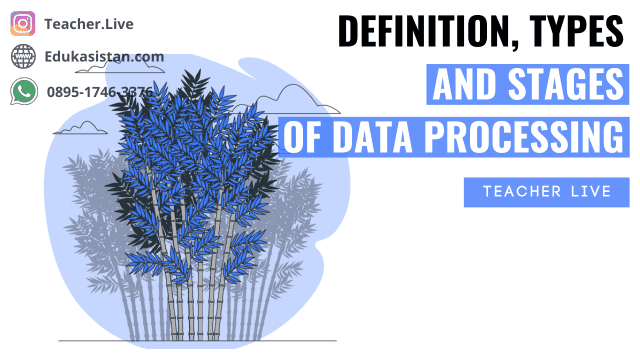Data analysis techniques: Definition, Types, and Stages of Data Processing
Edukasistan.com - Hello, everyone! Are you currently delving into the world of data analysis techniques in your college studies? If the answer is yes, you've landed in the perfect place! In this article, we're going to comprehensively discuss data analysis techniques, ranging from understanding the basics to the step-by-step data processing stages.
This read promises to offer you an in-depth understanding of the various types of data analysis techniques, both qualitative and quantitative, as well as the necessary data processing procedures to undertake before entering the stage of analysis.
Daftar isi
So, let's continue reading this article and discover new knowledge about data analysis techniques that will assist you in tackling your college assignments! What is Data Analysis? Data analysis is one of the aspects you'll encounter during your time in college.
Thus, you need to grasp it well to ease your way through your college tasks. In this regard, we're going to discuss the ins and outs of data analysis techniques in this article. Let's get reading!
Definition of Data Analysis Techniques
 |
| Definition, Types, and Stages of Data Processing |
To comprehend the definition of data analysis techniques, we need to look at the perspectives of several experts or scholars. Here are some of their views:
1. Prof. Dr. Sugiyono, Lecturer at Sebelas Maret State University (UNS)
According to him, data analysis techniques involve a challenging research process that requires hard work, creative thinking, and extensive insight. Sugiyono believes that each study is unique, particularly in the methods employed.
2. John Tukey, a mathematician from the United States
Tukey states that there are several crucial concepts to understand in data analysis techniques. In his view, data analysis is a procedure for interpreting data, techniques for interpreting the results of those procedures, and strategies for planning data collection to make analysis easier, accurate, and to apply appropriate statistical methods.
3. Prof. Dr. Lexy J Moleong, author of the book "Qualitative Research Methods" published by Rosdakarya
Prof. Lexy argues that data analysis techniques are analytical activities in a study that involve examining all data from research instruments, such as documents, notes, recordings, test results, and so on.
Based on these expert opinions, we can conclude that data analysis techniques are methods or ways to process data into information that is easy to understand and useful in finding solutions to research problems.
Types of Data Analysis Techniques
Data analysis techniques are generally divided into two types, qualitative and quantitative. Each type has its own strengths and weaknesses.
1. Qualitative Data Analysis Techniques
This is an analysis technique that focuses on non-numerical information with a positivist approach. In qualitative analysis techniques, the conceptual discussion of a problem is more emphasized rather than reliance on numerical data. Some types of qualitative analysis techniques include:
- Content analysis
- Narrative analysis
- Discourse analysis
- Framework analysis
- Grounded theory
2. Quantitative Data Analysis Techniques
This is an analytical activity that processes numerical data, such as statistical data, survey results, etc. Like qualitative analysis techniques, quantitative data analysis techniques also have several types, namely descriptive quantitative analysis and inferential analysis.
Data Processing Stages
Having understood the definition and types of data analysis techniques, now we need to know the stages of data processing. Knowing these stages will help us understand the basics of data processing.
- Editing: This stage involves checking all questions returned by respondents. The aim is to ensure that the collected data is complete and accurate.
- Coding: After the editing stage, data coding is performed. This is done by assigning symbols or signs in the form of numbers for each respondent's answer in the study.
- Tabulating: This stage involves arranging and calculating the coded data so that it can be presented in table form.
These three data processing stages are the initial steps in analyzing data. After passing through these stages, we will enter the data analysis process.
Data Analysis Stage
The data analysis stage is performed after we've passed through the data processing stage. The processed data will be analyzed and interpreted to be comprehensible as information.
At this stage, we'll choose the appropriate data analysis technique, be it qualitative or quantitative. The choice of method should be in line with the type of data processed and the analytical approach we use.
This stage requires high precision, guys! The process of data analysis is a crucial stage in research. We must interpret the data we have to answer the research questions we posed.
Interpretation of Analysis Results
After analyzing data in the previous stage, we need to interpret the results. When interpreting the results of the analysis, it's important to present evidence that supports our analysis.
To do this, we need to refer to various references that support our interpretation. The references used should be based on data and related research.
In interpreting the results of the analysis, we don't just rely on intuition and knowledge we have. We need to include clear and relevant references to explain the analysis results properly. Otherwise, our research might be less convincing.
As a simple tip, when interpreting the analysis results, we should see ourselves as novice readers. In this way, we can explain the research findings in an effective manner to an audience that doesn't have the same background.
That's some crucial information you need to know about Data analysis techniques. If you want to deepen your understanding, don't hesitate to keep following our articles. If there are any mistakes, we apologize and thank you for reading.

